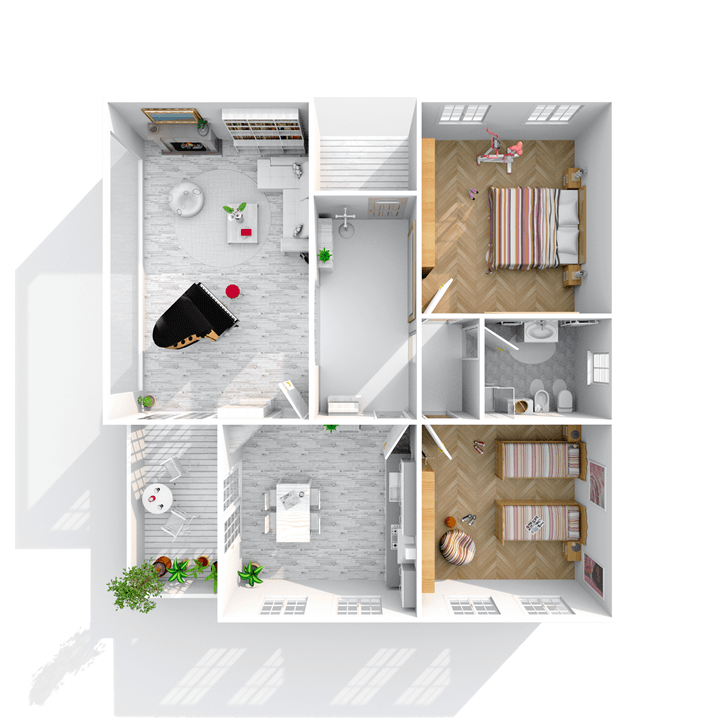Costs, consumption and saving of mechanical ventilation solutions
A Thesan ductless ventilation system running constantly, year-round, at medium speed, consumes as much as the red stand-by light on your television or HI-FI system, or as a digital picture frame. The analyses of the typical annual costs of Aircare compared against the costs of the most common household appliances are clear.
But that's not all. Aircare consumes very little and helps you save a lot on heating bills, as you can see in the configuration example provided below.
LET'S BE CLEAR ABOUT THE COSTS OF MECHANICAL VENTILATION SOLUTIONS
The use of mechanical ventilation in both dwellings and non-residential buildings is relatively recent. Like all new discoveries destined to change consolidated habits, at first people are generally slow to accept them. The main issues involve the energy consumption of the fans.
There is no reason for these unfounded fears that are often caused by lack of information or even misinformation. It's easy to check household energy consumption and the energy label has been around for ages now.
All electrical appliances on the market (microwave ovens, refrigerators, digital picture frames, electric kettles, blenders, juicers etc.) come with an energy label together with their Instructions. You can find out their expected energy consumption by reading the Manual.
CONFIGURATION EXAMPLE
OF AIRCARE SYSTEMS IN A HOME

FACTS ARE CLEARER THAN ASSUMPTIONS
It's not true that mechanical ventilation consumes too much- the cost of Aircare is moderate and easily repaid by the benefits it brings: good quality indoor air, the possibility of filtering incoming supply air, heat recovery of the exhaust air so you don't have to open the windows when it's cold, prevention of pollens from entering in spring and, last but not least, the absence of mould in residential environments.
It's easy to offset MVHR consumption: just get into the habit of turning off all the devices that we don't use continuously and that we usually leave on stand-by due to laziness.
HOW MUCH DOES A HOUSEHOLD APPLIANCE CONSUME?
The comparative table below is clear.
| Type of appliance | Typical or average use | Annual consumption (kWh) | Annual cost* (€) |
|---|---|---|---|
| LED light in kitchen | 4 hours a day | 7,3 | EUR 1.46 |
| TV stand-by light | 20 hours a day | 29,2 | EUR 5.84 |
| LCD TV (32") | 2 hours a day | 65 | EUR 13.00 |
| Average size (35-60 litres) Class A electric oven | 2 hrs a week | 75 | EUR 15.00 |
| Average size (35-60 litres) Class C electric oven | 2 hrs a week | 110 | EUR 22.00 |
| Incandescent light bulb in kitchen | 4 hours a day | 146 | EUR 29.2 |
| Class A washing machine | Two, 5-kg loads of cotton a week washed at 60°C | 230 | EUR 46.00 |
| Class A++ refrigerator | Always | 240 | EUR 48.00 |
| Class B washing machine | Two, 5-kg loads of cotton a week washed at 60°C | 270 | EUR 54.00 |
| Class B refrigerator | Always | 300 | EUR 60.00 |
| Class A++ split air-conditioner | 500 hrs/year | 320 | EUR 64.00 |
| Personal Computer | 6 hours a day | 876 | EUR 175.2 |
| Class C split air-conditioner | 500 hrs/year | 1000 | EUR 200.00 |
*average cost of supply: 0.20 €/kWh
Note: the estimates in the table refer to household appliances with good energy performance levels. Older appliances still used in our homes consume a lot more.
HOW MUCH AIRCARE CONSUMES
| Single room mechanical ventilation system | Typical or average use | Annual consumption (kWh) | Annual cost* (€) |
|---|---|---|---|
| Aircare AF at speed 3 | Always | 45 | EUR 9.00 |
| Aircare ES at speed 3 | Always | 90 | EUR 18.00 |
| Aircare AE at speed 3 | Always | 45 | EUR 9.00 |
*average cost of supply: 0.20 €/kWh




